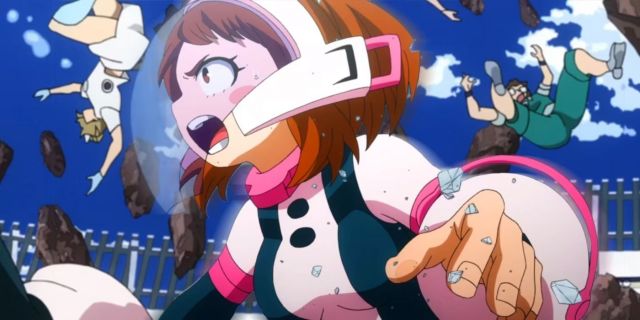Highlights
- Uraraka’s strong start as a well-rounded character was promising, but she was eventually relegated to a mere love interest with limited development.
- Despite early potential, Uraraka’s role in My Hero Academia became inconsequential as male characters took over the narrative focus.
- My Hero Academia fell into the common shonen trap of neglecting female characters like Uraraka, missing opportunities for meaningful growth and development.
My Hero Academia has an expansive character lineup, with each one brimming with immense potential. With limited screen time, however, boasting a large roster of characters can be detrimental to the series. This is especially true for female characters in shonen anime, as they tend to bear the brunt of time constraints and often end up being sidelined. Ochaco Uraraka is a prime example of this phenomenon, and how a well-written female character is eventually relegated to the sidelines with no part in the narrative.
Uraraka’s characterization of a strong, empowered female character was wholly welcomed during the initial parts of the show, but My Hero Academia had different plans for this character. Slowly but surely, Uraraka went from a major character to a mere love interest and side character, which stripped her of her initial potential. The series seems to have fallen into a common shonen trap, where the male characters enjoy character development and screen time, while their female counterparts fall victim to neglect and irrelevancy.
What Uraraka Initially Had to Offer

Uraraka was introduced within the first few episodes of the show, and her lovable personality and grounded goals quickly deemed her a fan-favorite. Right off the bat, Uraraka became one of Deku’s primary supporting characters, but despite playing the role of a friend, Uraraka maintained her own independence.
Unlike other shonen females that have their goals tied to male characters, Uraraka started off with her own unique goals. Her aspirations for becoming a hero just to earn money and support her family resonated with fans, as this humble goal added relatability to her character. A few major moments added on to her already-increasing popularity, and fans anticipated more growth for the character.
Uraraka’s Growth Through Battle

One of the very first moments where Uraraka truly shined was her fight against Bakugo in the U.A. High Sport Festival. Despite possessing a utility quirk that has limited offensive capabilities, Uraraka showcased tact, keen intellect, and most importantly, a resolve to never give up. This was one of Uraraka’s earliest highlights, and she immediately cemented herself as one of 1-A’s top contenders.
I’ll win! I’ll win and be like Deku too!
Uraraka’s decision to train in martial arts under Gunhead was also inspired by her battle against Bakugo, as she realized the missing gaps in her repertoire. This training came in handy during the League of Villains ambush during the Forest Training arc, where Uraraka took on Himiko Toga with her newfound hand-to-hand combat skills. By this point, things were looking up for Uraraka, but unfortunately, her characterization only went downhill afterward.
Where Did My Hero Academia Go Wrong?

With so many characters populating the narrative, it’s only natural for a select few to be at the forefront, while the rest accept their place on the sidelines. However, My Hero Academia switched up its focus one too many times. Initially, Uraraka was believed to be one of the focal characters of the series, and her friendship with Deku further led fans into believing this to be true.
Midway through the show, however, this spotlight shifted drastically, with Deku, Bakugo, and Shoto becoming the primary focus of the show. Uraraka, along with the rest of her classmates, were forced to take the backseat. However, this change was the most apparent in Uraraka’s case, as she went from a primary ancillary character to a mere love interest with little to no screen time.
Uraraka Was Relegated to a Love Interest

In the beginning of My Hero Academia, Deku would occasionally get flustered around Uraraka, and his sentiments towards her would often lead to a few amusing situations. However, the series flipped the script entirely, thrusting the role of the awkward romantic on Uraraka. Deku’s characterization never suffered due to these moments, yet the same cannot be said for Uraraka.
Romance has never impeded a character’s growth, but when being a love interest is the only thing going for the character, a few issues are bound to arise. This is exactly the case for Uraraka, as her screen time greatly diminished past season 2 of the show, and the only scenes she would receive would entirely revolve around admiring Deku from afar.
Too Many Characters Took Over the Narrative

Despite being one of the most popular characters in My Hero Academia, Uraraka’s role in the series is rather inconsequential. Taking her out of the equation would change nothing for the show’s narrative, and the few places she receives some attention are quite insignificant. Compared to other ancillary characters such as Bakugo and Shoto, Uraraka has never exactly been an integral part of the plotline.
While it’s natural for characters to be sidelined due to a massive roster, author Horikoshi had multiple opportunities to expand on Uraraka’s characterization. Her initial goals for becoming a hero were never brought up again, and her rivalry with Toga was also forgotten. These plotlines could have served as a major character arc, but My Hero Academia already had its hands full with its overcrowded lineup.
Uraraka’s case could easily be deemed another example of poor female writing in shonen anime, but her promising start points towards a few other issues that run much deeper. From a lack of consistent screen time to a hesitancy to bring female characters on par with their male counterparts, My Hero Academia’s is riddled with imparity, and Uraraka’s potential has become a victim to these glaring problems.
My Hero Academia is available to stream on Prime Video.











Leave a Reply